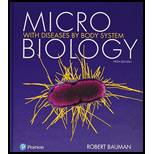
Concept explainers
Some people consider Leeuwenhoek the “Father of
To tell:
Why some people consider Leeuwenhoek as the “Father of Microbiology”.
Introduction:
Antonie van Leeuwenhoek revealed the first unicellular organism, which are termed as “protozoa”. Leeuwenhoek established the microscope and set the foundation for the field of microbiology. He is the first person to study about sperm cells, blood circulation in capillaries, muscle fibers, and bacteria.
Explanation of Solution
Antonie van Leeuwenhoek improved the world of science forever by creating his simple microscope. He learned to create a magnifying glass lens (convex) of his own. The lens had a screw (handling the specimen) and a sample holder. His passion in life was to observe everything through his simple microscope. Furthermore, he created a new microscope for individual samples. One day, he observed water droplets with oval, round shapes, some green streaks, spirally-shaped structures, and some locomotor animalcules – the unknown world of microbes.
The presence of bacteria was first described by Antonie van Leeuwenhoek. His invention of microscopes aided in the discovery of many new microorganisms. Hence, he is recognized as the “Father of Microbiology”.
Want to see more full solutions like this?
Chapter 1 Solutions
Microbiology with Diseases by Body System (5th Edition)
- In one paragraph show how atoms and they're structure are related to the structure of dna and proteins. Talk about what atoms are. what they're made of, why chemical bonding is important to DNA?arrow_forwardWhat are the structure and properties of atoms and chemical bonds (especially how they relate to DNA and proteins).arrow_forwardThe Sentinel Cell: Nature’s Answer to Cancer?arrow_forward
- Molecular Biology Question You are working to characterize a novel protein in mice. Analysis shows that high levels of the primary transcript that codes for this protein are found in tissue from the brain, muscle, liver, and pancreas. However, an antibody that recognizes the C-terminal portion of the protein indicates that the protein is present in brain, muscle, and liver, but not in the pancreas. What is the most likely explanation for this result?arrow_forwardMolecular Biology Explain/discuss how “slow stop” and “quick/fast stop” mutants wereused to identify different protein involved in DNA replication in E. coli.arrow_forwardMolecular Biology Question A gene that codes for a protein was removed from a eukaryotic cell and inserted into a prokaryotic cell. Although the gene was successfully transcribed and translated, it produced a different protein than it produced in the eukaryotic cell. What is the most likely explanation?arrow_forward
- Molecular Biology LIST three characteristics of origins of replicationarrow_forwardMolecular Biology Question Please help. Thank you For E coli DNA polymerase III, give the structure and function of the b-clamp sub-complex. Describe how the structure of this sub-complex is important for it’s function.arrow_forwardMolecular Biology LIST three characteristics of DNA Polymerasesarrow_forward
- Molecular Biology RNA polymerase core enzyme structure contains what subunits? To form holo enzyme, sigma factor is added to core. What is the name of the structure formed? Give the detailed structure of sigma factor and the function of eachdomain. Please help. Thank youarrow_forwardMolecular Biology You have a single bacterial cell whose DNA is labelled with radioactiveC14. After 5 rounds of cell division, how may cells will contain radioactive DNA? Please help. Thank youarrow_forward1. Explain the structure and properties of atoms and chemical bonds (especially how they relate to DNA and proteins). Also add some pictures.arrow_forward
 Biology Today and Tomorrow without Physiology (Mi...BiologyISBN:9781305117396Author:Cecie Starr, Christine Evers, Lisa StarrPublisher:Cengage LearningEssentials Health Info Management Principles/Prac...Health & NutritionISBN:9780357191651Author:BowiePublisher:Cengage
Biology Today and Tomorrow without Physiology (Mi...BiologyISBN:9781305117396Author:Cecie Starr, Christine Evers, Lisa StarrPublisher:Cengage LearningEssentials Health Info Management Principles/Prac...Health & NutritionISBN:9780357191651Author:BowiePublisher:Cengage





